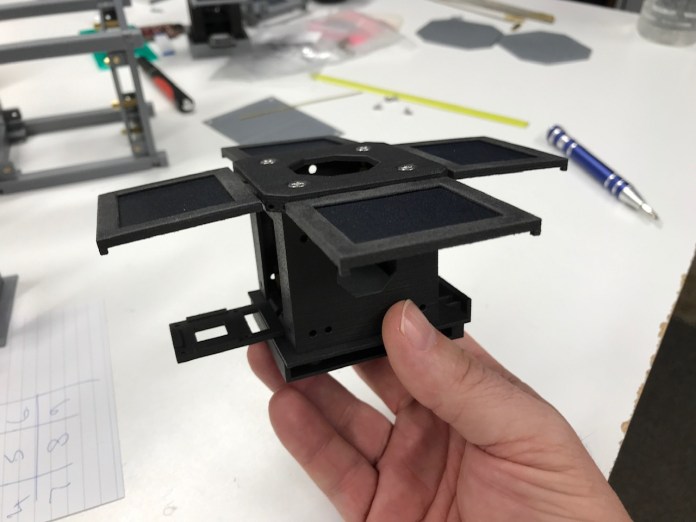Mini-Cubes, LLC was founded with the idea that anyone can see what happened in space, even virtually. To make it happen, the team develops super small satellites called PocketQube. Each PocketQube aims to achieve “a better grasp on resource monitoring and give the public a chance to be among the stars”.
As part of their last project, Discovery, the company’s founder Joseph Latrell and his team call for CRP USA, to produce an entire satellite frame. The technology company has built extensive expertise in enabling demanding industries including the space, automotive and motorsports to achieve their products. To do so, the team at CRP Group always relies on their Laser Sintering process and Windform® TOP-LINE reinforced composite materials, developed by the Italy-based subsidiary.
“When we started working on Discovery, I knew I wanted to push the boundaries of what was possible – everything from the small satellite form factor to the technology used to make it” the founder says.
Latrell explains that the main goal of Discovery is “to include a camera for visual observation — again just to see if it could be done–.” “If the process worked, we [would have considered the use of this technology] to create a constellation of PocketQube satellites for monitoring a specific resource. In our case that resource is water.”, the founder adds.
At the manufacture level, it was quite challenging to use a Carbon-composite material to build an entire material, given the small dimension of the prototype. As per the words of Latrell, this first assignment was a tough one as these small spacecrafts have an internal volume of 50mm x 50mm x 50mm.
“Our particular satellite is a demonstration of what can be done for remote sensing of Earth’s resources on that scale. The challenge with something so small is to fit the electronics, camera, and radio system into it”, the founder continues. “This was the first time an entire satellite [was] manufactured from a material like Windform® XT 2.0. Performance is [therefore] everything. If any one of the parts [failed], it would [have resulted] in complete failure of the spacecraft”, he clarifies.
For the production, the team used the Carbon-fiber reinforced Windform® XT 2.0. CRP USA said the material replaces the previous formula of Windform® XT in the Windform® TOP-LINE family of composite materials. Furthermore, it improves the material properties of the part in several ways:
+8% increase in tensile strength, +22% in tensile modulus, and a +46% increase in elongation at break, mechanical properties that enable to get a part with the desired stiffness, low mass and smooth surface finish.
The project required three 1P PocketQubes functional prototypes: two of them were meant for testing and the other one for flight. “So far, we have load tested to over 20 Kg. The material has been vibration tested to NASA GEVS-7000 specifications, subjected to a near vacuum to simulate the conditions in Earth orbit, and thermally tested from +50c to -40c. Windform® XT 2.0 has passed every test we threw at it”, Mini-Cubes enthuses.
The 3D printed 1P PocketQubes functional prototypes have successfully passed the control and testing criteria and have fully complied with the requests and Mini-Cubes’ standards.
“The next step for us is to test the satellite on orbit. This will be the final validation for our process. The plan is to launch sometime in Q2 2021”, Latrell concludes.
Remember, you can post AM job opportunities for free on 3D ADEPT Media or look for a job via our job board. Make sure to follow us on our social networks and subscribe to our weekly newsletter: Facebook, Twitter, LinkedIn & Instagram! If you want to be featured in the next issue of our digital magazine or if you hear a story that needs to be heard, make sure to send it to contact@3dadept.com


